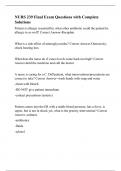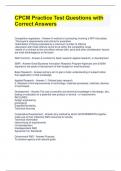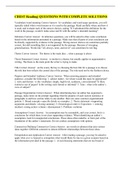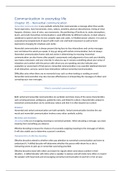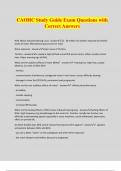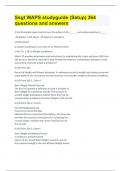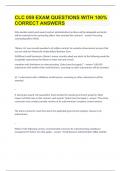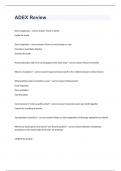MAREX Week 1
Chapter 1 – Export Management From A European And A Global Perspective
Learning Objectives
• Which countries are the biggest exporters? (1.1)
• Describe (dis)advantages of a free trade policy (1.3)
• Describe some different forms of protectionism (1.3)
• Which different kinds of trade blocks can be distinguished? (1.4)
1.1 Export in A Global Context
The World’s Biggest Exporters:
1. China 6. France
2. USA 7. Netherlands
3. Germany 8. Italy
4. Japan 9. UK
5. South Korea 10. Canada
• More than 70% of Dutch goods and services are destined for export (within the EU)
• A stable European market is essential for Dutch export.
1.2 Definitions of Important Exporting Terms
Export & Import Terms
Export – The sale and delivery of goods/services to another country
Import – Bringing goods/services from abroad into a country for sale
Re-importation – Importation with added value of products that had first been exported (e.g.
metal products)
Re-exportation – Exportation of imports with little added value (e.g. flowers)
Transit – Shipping of goods that physically arrive in a certain country and are traded freely
but remain the property of a foreign resident (e.g. container transport)
International trade – All exchanges of goods and services that cross national borders.
Also concerns import, export and trade against money and the exchange of goods
Companies expand abroad by selling products in foreign markets (export) or by establishing
subsidiaries and/or strategic business units (SBU’s)
Global sourcing
The search for the optimal place to establish facilities
Strategy where a company moves company processes that are not bound to a specific
geographical location to parts of the world where costs can be cut and more value can be
added
Processes can also be taken care of by third parties in places in the world where this may be
done more favorably
Result of differences in production cost, can be seen as a reason for the emergence of
international trade
, MAREX Week 1
1.3 Trade Policies
Trade Policy – A measure that a government of a country may take in order to influence the
exchange of goods/services that are internationally traded (e.g. taxes, subsidies, import/export
regulations)
2 main trade policy theories are: 1. Free Trade 2. Protectionism
1. Free Trade
Free trade policy – International trade is carried out entirely according to the laws of supply
and demand
Free trade means that countries can import and export goods without any tariff barriers or
other non-tariff barriers
Essentially, free trade enables lower prices for consumers, increased exports, benefits from
economies of scale and a greater choice of goods
Trade war – economic conflict resulting from extreme protectionism in which states raise or
create tariffs or other trade barriers against each other in response to trade barriers created by
the other party
Most important policy of free trade is laid down in the General Agreement of Tariffs and
Trade (GATT)
GATT
Objective abolish mutual trade barriers
WTO
Check adherence to the GATT treaty
Provide new stimuli to negotiations, initiate trade related policies
Advantages Disadvantages
Efficient competition leading to Doesn’t allow cyclical movements
technological innovation and the influence of emotions,
Doesn’t provoke counter measures culture and religion on the behavior
that could lead to a trade war and opportunities of companies
Stabilization of prices, countries The effects of the comparative costs
and organization and no allowance is made for the
Knowing in advance what rules to limitations of these effects
adhere to Developing countries argue that free
trade discriminates against them,
harder for them to grow
2. Protectionism
Protectionism refers to government actions and policies that restrict or restrain international
trade, often with the intent of protecting local businesses and jobs from foreign competition
This results in the controlling of prices/quantities
Chapter 1 – Export Management From A European And A Global Perspective
Learning Objectives
• Which countries are the biggest exporters? (1.1)
• Describe (dis)advantages of a free trade policy (1.3)
• Describe some different forms of protectionism (1.3)
• Which different kinds of trade blocks can be distinguished? (1.4)
1.1 Export in A Global Context
The World’s Biggest Exporters:
1. China 6. France
2. USA 7. Netherlands
3. Germany 8. Italy
4. Japan 9. UK
5. South Korea 10. Canada
• More than 70% of Dutch goods and services are destined for export (within the EU)
• A stable European market is essential for Dutch export.
1.2 Definitions of Important Exporting Terms
Export & Import Terms
Export – The sale and delivery of goods/services to another country
Import – Bringing goods/services from abroad into a country for sale
Re-importation – Importation with added value of products that had first been exported (e.g.
metal products)
Re-exportation – Exportation of imports with little added value (e.g. flowers)
Transit – Shipping of goods that physically arrive in a certain country and are traded freely
but remain the property of a foreign resident (e.g. container transport)
International trade – All exchanges of goods and services that cross national borders.
Also concerns import, export and trade against money and the exchange of goods
Companies expand abroad by selling products in foreign markets (export) or by establishing
subsidiaries and/or strategic business units (SBU’s)
Global sourcing
The search for the optimal place to establish facilities
Strategy where a company moves company processes that are not bound to a specific
geographical location to parts of the world where costs can be cut and more value can be
added
Processes can also be taken care of by third parties in places in the world where this may be
done more favorably
Result of differences in production cost, can be seen as a reason for the emergence of
international trade
, MAREX Week 1
1.3 Trade Policies
Trade Policy – A measure that a government of a country may take in order to influence the
exchange of goods/services that are internationally traded (e.g. taxes, subsidies, import/export
regulations)
2 main trade policy theories are: 1. Free Trade 2. Protectionism
1. Free Trade
Free trade policy – International trade is carried out entirely according to the laws of supply
and demand
Free trade means that countries can import and export goods without any tariff barriers or
other non-tariff barriers
Essentially, free trade enables lower prices for consumers, increased exports, benefits from
economies of scale and a greater choice of goods
Trade war – economic conflict resulting from extreme protectionism in which states raise or
create tariffs or other trade barriers against each other in response to trade barriers created by
the other party
Most important policy of free trade is laid down in the General Agreement of Tariffs and
Trade (GATT)
GATT
Objective abolish mutual trade barriers
WTO
Check adherence to the GATT treaty
Provide new stimuli to negotiations, initiate trade related policies
Advantages Disadvantages
Efficient competition leading to Doesn’t allow cyclical movements
technological innovation and the influence of emotions,
Doesn’t provoke counter measures culture and religion on the behavior
that could lead to a trade war and opportunities of companies
Stabilization of prices, countries The effects of the comparative costs
and organization and no allowance is made for the
Knowing in advance what rules to limitations of these effects
adhere to Developing countries argue that free
trade discriminates against them,
harder for them to grow
2. Protectionism
Protectionism refers to government actions and policies that restrict or restrain international
trade, often with the intent of protecting local businesses and jobs from foreign competition
This results in the controlling of prices/quantities



